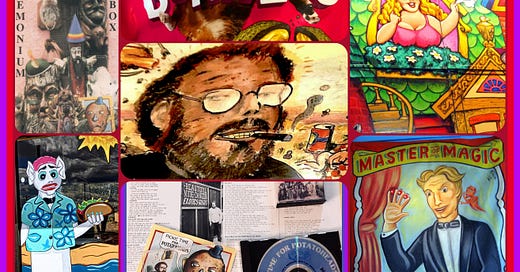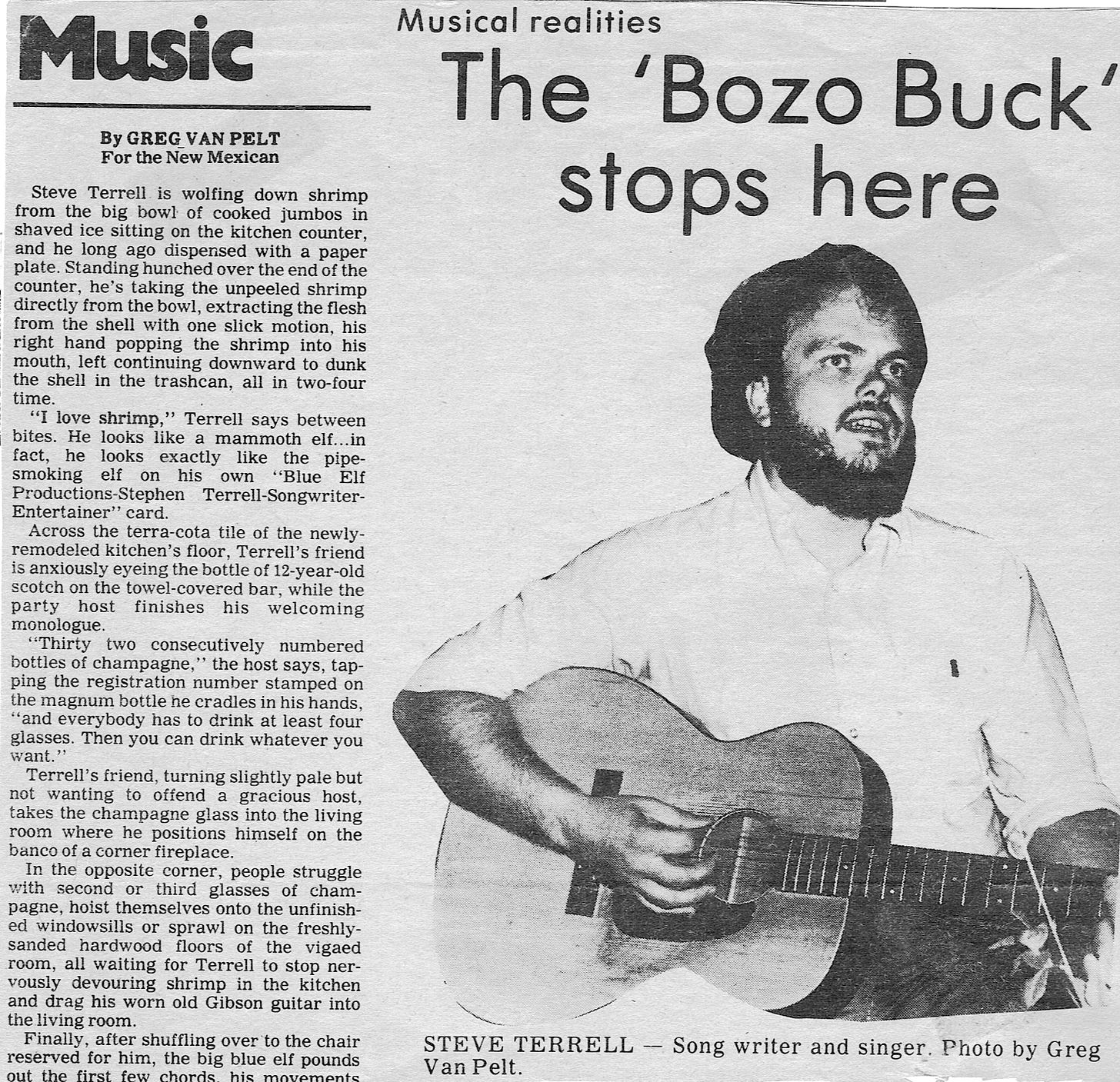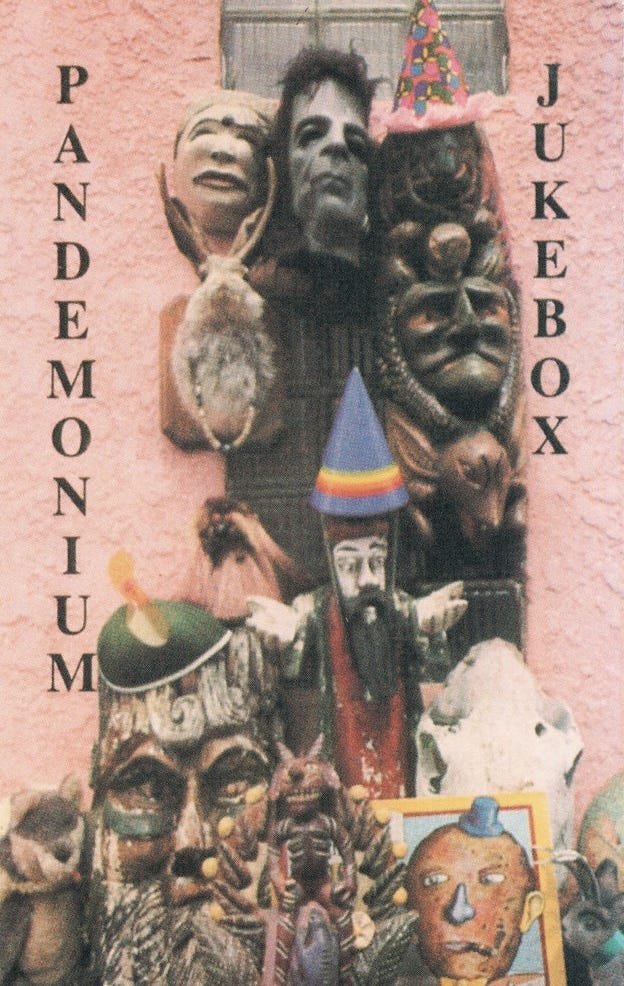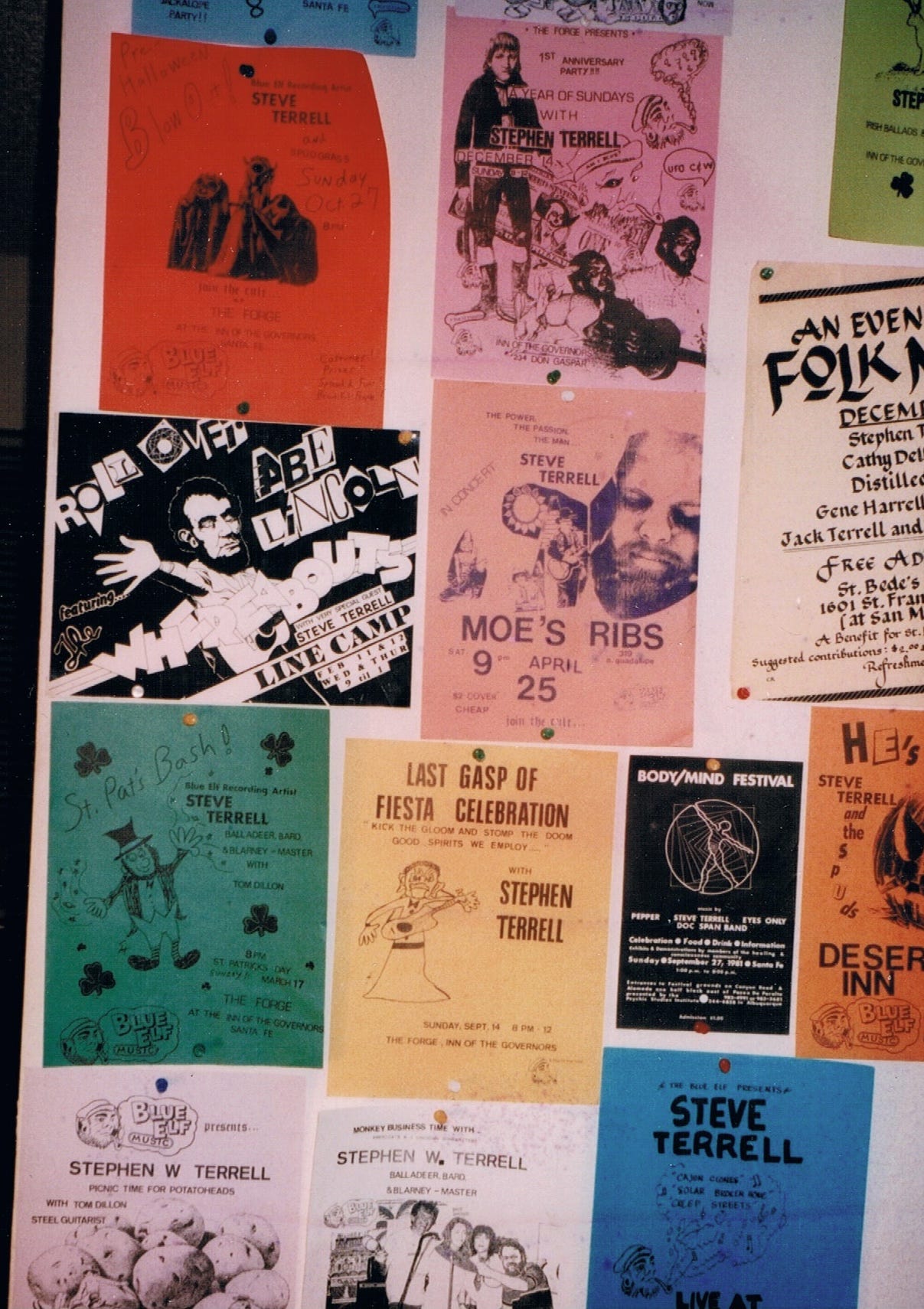Welcome to Songs The Wild Taters Sing, my new project on Substack!
Like my recently completed Steve Terrell’s Snazzy Life -- which made public the autobiographical vanity book I wrote back in 2021 -- I think this new project is going to be pretty snazzy.
As many of you know, before my dabble in journalism developed into what would become a three-decade career, I used to consider myself a songwriter.
After all, I share my birthday with a guy named Leonard Cohen -- though admittedly, he’s a thousand floors above me in the Tower of Song.
But I did make two albums, both in the early 1980s.
First was Picnic Time For Potatoheads (1981), recorded at John Wagner Studios in Albuquerque with my brother Jack’s band, The Whereabouts (Jack on guitar, Mike Roybal on bass and Dave Valdez on drums) plus assorted other musical pals on various tracks.
Then came the even lesser-known Pandemonium Jukebox (1984), a cassette-only project. Potatoheads didn’t make enough money to spend on a studio or vinyl manufacturing for this second effort.
I was a no-hit wonder.
But I felt the primal need back then to unleash more music on the public – whether or not the public gave a flying hoot.
Kind of like the reason I’m writing these Substack “publications.”
Some background on my history as a “musician”:
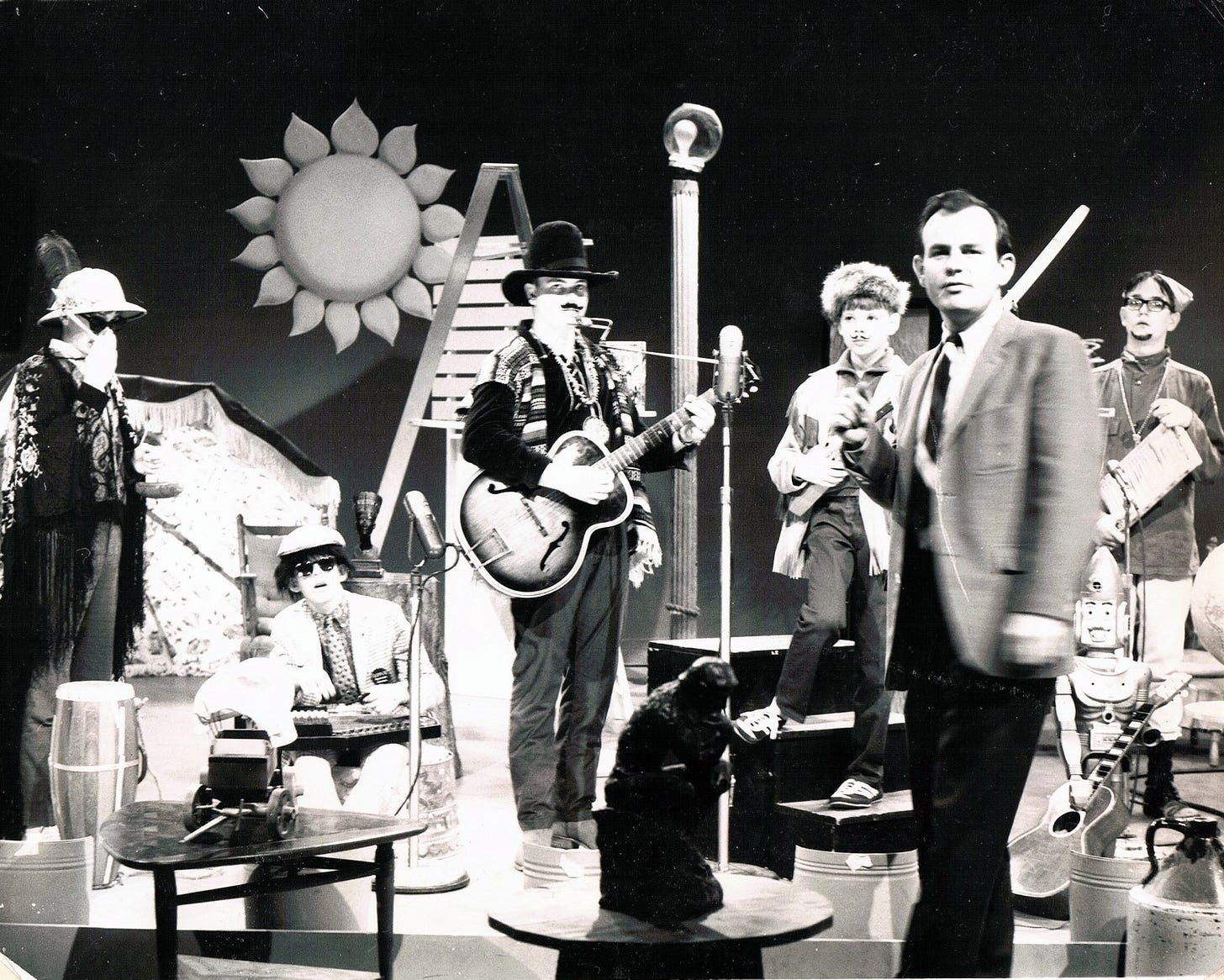
As I mentioned a few times in Snazzy Life (this being the best example), I’ve been a music freak from a very early age. The first actual band with which I ever performed, back when I was in junior high in Oklahoma City, was a “jug band” called The Ramhorn City Go-Go Squad & Uptight Washtub Band.
(Shoutout to my old Squad-mates, Pat Chrislip, Todd Hunter, Jeff Midkiff (RIP), Kris Lackey and my brother, Jack.)
We played talent shows and assemblies at Eisenhower Junior High, church suppers, civic organization lunches – and a couple of times on local afternoon TV shows.
And a year or so after Jack and I moved to New Mexico in 1968, we formed a Santa Fe version of the band – along with Steve Severtson, David Thompson and Matt Peterson.
This curious endeavor was sparked by an art contest sponsored by my favorite radio station of that day, WKY. There was a popular novelty song back in late 1966 called “The Eggplant That Ate Chicago” by a group called Dr. West’s Medicine Show & Junk Band.
In case you’ve never heard it …
So WKY sponsored a contest in which listeners were asked to draw this monster eggplant. I got out my crayons and submitted a picture.
And the first day after Christmas break, friends at school informed me that they’d heard on the radio that I was one of the winners. My prize was a copy of the album, also titled The Eggplant That Ate Chicago.
That would have been January 3, 1967. I remember that date because that’s the day my grandfather died. Maybe that’s a reason this silly record meant so much to me. (Skip ahead to the late ‘90s and I’d review a Dr. West compilation for No Depression magazine.)
With Ramhorn City, we covered several Dr. West songs; a gawdawful Arthur Godfrey song called “Heap Big Smoke But No Fire” (featuring stupid stereotyping of Native Americans); Country Joe’s Vietnam war protest, “I-Feel-Like-I'm-Fixin'-to-Die Rag”; and, perhaps ominously, a kiddy song called “Teddy Bear’s Picnic,” which had been covered by The Nitty Gritty Dirt Band; and other strange tunes.
And we did several of my originals like “The Ballad of Clark the Aardvark,” “Tizzic Cream” and others that have been – probably fortunately -- forgotten.
After high school, and throughout most of my college years, I basically stopped performing. I still wrote some songs now and then. But few if any of them were any good … at least until the mid 70s, when I started writing a few tunes – such as “Cook Yer Enchiladas” and “Life of Ease” – that I wasn’t embarrassed to play at stoned late-night jam sessions.
Around 1977, Jack and I had started performing in various joints, our first gig being at Espanola’s Saints & Sinners lounge, where we played for a group of friends and were paid with two bottles of scotch.
Then I got a regular Sunday night gig at Faces, a little bar in DeVargas Mall. By this point I was playing mostly original songs. But this gig lasted only a few months before the bar shut down in late 1978.
I was without a steady gig for about a year.
But finally that next summer, I convinced the manager of The Forge, (at the time was the bar for the Inn of the Governors) in downtown Santa Fe) to give me, I think three gigs that fall.
And a few weeks before that, I somehow convinced The Santa Fe New Mexican to send a freelance reporter out to go to a private party I’d been hired to play. This was nearly a decade before I even started working at the paper as a journalist.
The party was attended by a bunch of my old Faces crowd. And the story by writer Greg Van Pelt (RIP) – was terrific.
The three gigs at The Forge turned into three and a half years of crazed Sunday nights there.
During those impoverished but exciting years, I built a loyal, enthusiastic, sometimes obnoxious, usually drunken group of fans, many of whom became friends, that I lovingly referred to as my “cult.”
There were more local newspaper stories. The cult kept growing. For years, Sunday night would be the highlight of my week.
Once a German television crew even came to the Forge and paid me to shoot a show. They filmed few other local musicians as well. I never saw the documentary they were working on, so I can’t say how much footage from my show, if any, was used.
One Sunday night my artist buddy Paul Milosevich brought his friend Tom T. Hall to my Forge gig. And that very night, another Milosevich crony Butch Hancock joined me onstage for a rousing rendition of “America the Beautiful.”
In addition to The Forge, I branched out a little, doing gigs wherever I could get them. I began a relationship with KUNM radio in Albuquerque, appearing at least a couple of times on the Saturday afternoon live music show they had at the time, as well as Home of Happy Feet, the station’s venerated folk music show, which began in the mid ‘70s and wrapped up just last month (January, 2025!)
For years I’d dreamed of recording an album. By 1981, with the help of a couple of friends – Alec Walling and Bob Sander – who offered to put up the money to record one, I was able to do it. (I still feel a little guilty that Alec and Bob never recuperated their ill-advised investment.)
Always aware of my own limitations as an instrumentalist, I enlisted my brother Jack – whose musical skills had grown dramatically since our Ramhorn City daze. We started rehearsing my songs with his band.
Jack wanted to record at John Wagner studios, where our friend, country singer Mose McCormack recorded his albums. Check the video below:
Wagner’s studio at the time was just a block or two north of East Central near Wyoming N.E. The first thing that impressed me about the joint was Wagner’s wall of photographs and album covers from the likes of Merle Travis, who had recorded there.
Wagner, a native of Clovis, N.M., started learned under a local named Norman Petty, whose studio was responsible for Buddy Holley’s biggest hits as well early recordings of Roy Orbison, Waylon Jennings, The Fireballs and others.
So we made Picnic Time for Potatoheads at Wagner’s studio. As the liner notes proudly proclaimed, we recorded it “in two weeks flat!”
Though I didn’t have a full-time job then, I had begun freelance writing, mostly music stories, for The Santa Fe Reporter.
I almost missed a Friday night recording session in Albuquerque because I was waiting to do an interview in Santa Fe with reggae star Peter Tosh, who eventually stiffed me.
But we trudged through and completed the work. And by the end of the year I had in my hands my first album.
It never made the Big Time. Not even the Medium Time. But there were a few little milestones I’m proud of. Among them:
* The mighty Dr. Demento played a few tracks off Potatoheads on nhis nationally syndicated show.
* It became a favorite on Gilroy, California’s KFAT Radio, known for playing “a quirky mix of country, blues, old-timey music, raunchy comedy, bluegrass, Hawaiian, and whatever struck the fancy of the disc jockey.”
And though Potatoheads didn’t make any money, one thing I got out of it was a bitchen California vacation, doing a few radio interviews (including one on KFAT) but generally just puttering around the Golden State in a Potatohead van, as described in Chapter 30 of Snazzy Life.
But the thrill didn’t last very long.
By 1983, my marriage was falling apart. Also that year, I’d started working full time at The Santa Fe Reporter, which is something I’d wanted for more than a year and truly enjoyed most of the time. But as any journalist knows, it could be very stressful some days -- or weeks!
Also, my weekly gig at The Forge ended, which led to some truly depressing days. And to add a grim cherry to this shit sundae, on his way home from my final Sunday there, Kim, a popular Forge bartender and all around decent guy, died in a car crash on his way home.
I recall the Monday after getting canned at The Forge I had to go to a local funeral parlor for some Reporter assignment.
But before I even got out of my car, I broke down in tears right in the mortuary parking lot — my private funeral for my music career. It wasn’t literally over, but I knew its days were numbered.
But through these troubled times, there were bright spots. My baby daughter, for one. My budding role as a journalist for another.
And there was my new music project.
During my last couple of years doing regular gigs at The Forge, my friend Tom Dillon, who played steel guitar on a couple of Potatoheads songs, had become my regular onstage accomplice. For a while, we added another friend, Harri Wolf on accordion and later some guy named Jeff on electric guitar, and called ourselves “The Potato Salad Band.”
And soon after he started regularly joining me onstage, Tom rented a house next door to me on Houghton Street. At some point he bought a 4-track Fostex cassette machine. Naturally we started fucking around with it. And by December of 1983, we started recording new songs as well as several old ones that hadn’t made it to Potatoheads.
And thus sprang the lo-fi (a full decade before “lo-fi” became a thing in “alternative rock”), cassette-only Pandemonium Jukebox.
After the financial tanking of Potatoheads I was too sheepish to go seek outside funding. So instead of a professional studio like Wagner’s, we recorded in Tom’s back bedroom, which we dubbed “The Luxurious Electro-elf Studios.”
Most the tunes were just Tom and me. In the liner notes for Panda Juke, I credited him for “Musical Substance, a thousand guitars, pedal steel, bass, banjo, dobro, wild percussion, dingy dongies, knobs, cold sweat, mayonnaise.”
A few songs involved other friends on other instruments and vocals. One of those “vocalists” went on to actual fame, albeit in a different field. I’ll reveal that name in a future chapter here. . (I’m such a tease.)
Skipping ahead more than a decade, in the mid ‘90s I decided I needed to get my music onto CDs.
Unfortunately some idiot at the manufacturing company in Tennessee had lost the original master for Potatoheads. But good old John Wagner still had the original 2-inch 16 track tapes from the Potatoheads sessions.
So my brother and I, along with Tim Stroh at the old Stepbridge Studios here in Santa Fe remixed and digitalized the whole mess into a compact disc called Picnic Time for Potatoheads and Best-Loved Songs from Pandemonium Jukebox.
We didn’t have room on the CD for all the songs from Panda Juke. But there was room for nine of them.
Maybe, if enough people bug me about it, I might do a chapter on those three missing songs. Or maybe even some of my more recent weird tunes that are floating about in weird corners of the World Wide Web.
But I’m not promising that yet.
So look for the first chapter (actually for this I’m calling them “tracks,” like on an album) next Tuesday.
Subscribe, dagnabbit! And hopefully this party will never be a dud …
Get your own copy of Picnic Time for Potatoheads & Best-Loved Songs from Pandemonium Jukebox HERE

